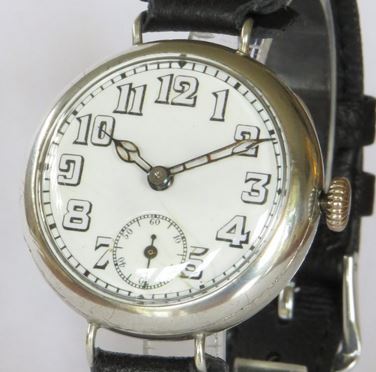Last updated on June 14, 2024
A luminous dial on a trench watch was a necessity for life in the trenches. Just because it was dark, didn’t mean the war came to a halt. Knowing the time was always a requirement in the trenches. If you couldn’t see the dial in the pitch black of night you had few options. Lighting a match or raising a lantern created a dangerous scenario whereby you could become victim to a sniper’s bullet. There needed to be another way of illuminating the dial, without drawing attention to oneself. That’s where radioactive luminous paint entered the equation.
Radium paint
The luminous paint used on World War 1 trench watches was made with a mixture of radium and zinc sulphide phosphor doped with an activator, usually copper. The zinc sulphide phosphor glowed brightly when hit by radiation from the radium. This paint glowed constantly, day and night, without needing any exposure to sunlight. The paint continued to glow even when stored away from the light. However, after about three years the zinc sulphide phosphor was burned out by the continual radiation bombardment and no longer glowed in the dark. The trench watches could have the dials and hands repainted when the zinc sulphide phosphor burned out. Even though the watch had ceased to glow the radium had hardly decayed at all and was still emitting radiation.
Health issues
At the time nothing was known about the danger of radiation and factories were full of staff applying the radioactive paint to the enamel dials. During World War 1 these factories were mainly staffed by women. The exposure to radium caused countless health issues and many needless deaths. The women were oblivious to the danger. They often “pointed” their brushes on their lips in order to give them a fine tip. Additionally, some also painted their fingernails, face and teeth with the glowing substance. In the 1920s the danger became noticed. However, with a lack of a suitable substitute, radium paint continued to be used. It wasn’t until the 1950s that the health issues were officially recognised. Despite this, the use of radium paint for military applications continued until the 1960s.
So, what does this mean for the trench watches in your collection? Many trench watches available on the market have hands and dials that seem to be clear of paint. This is because as the dangers of radiation were recognised the dials and hands were cleaned. This doesn’t mean your watch is now clear of radioactive material. Under magnification, it may still be possible to view remnants of the original radium paint. If you keep in mind that radium has a half-life of 1600 years the remaining material is still highly radioactive. This is even though it no longer has luminescent qualities.
Radium traces
Additionally, even a cleaned dial may still have traces of paint or tiny flecks of radioactive matter floating beneath the dial. Only a medical expert could advise on the exact dangers involved. A Geiger counter may indicate if your trench watch has radioactive content. The biggest danger is dropping your watch and smashing the watch crystal. This could release tiny fragments of radioactive paint from the dial which could be inhaled into your lungs. The watch below, from my collection, contains traces of paint at the tip of the hour hand. It isn’t visible to the naked eye, but is clear under magnification.
The choice to own a potentially radioactive timepiece is personal. If you are concerned about the radioactivity it is probably best to focus your attention on other antique watches. I wear my trench watches, perhaps once or twice a year. Therefore I feel that the exposure is minimal and I am happy to continue expanding my collection.
Related content
A list of additional posts regarding antique watches can be found on the Guides page.


Very interesting article. I have an old wrist watch that has been passed down through the generations. I belive it dates from around the first world war. It doesn’t work and just sits in a drawer. There is no name on the dial or the movement. There is paint on the dial and the hands, but it doesn’t glow in the dark. According to this post, the paint will still be radioactive?
Hi Gilbert, yes if it is actually luminous paint made with radium it will still be radioactive for centuries to come. Thanks for commenting, Jason